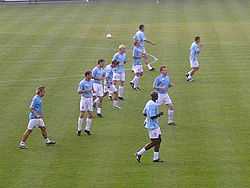Warming up


Warming-up is performed before a performance or practice. Athletes, singers, actors and others warm up before stressing their muscles.
Sports/exercise
A warm-up generally consists of a gradual increase in intensity in physical activity (a "pulse raiser"), joint mobility exercise, and stretching, followed by the activity. Warming up brings the body to a condition at which it safely responds to nerve signals for quick and efficient action.
For example, before running or playing an intense sport, the athlete might slowly jog to warm their muscles and increase their heart rate. It is important that warm ups be specific to the activity, so that the muscles to be used are activated. The risks and benefits of combining stretching with warming up are disputed, although it is generally believed that warming up prepares the athlete both mentally and physically.
Warm-up programs can improve the strength of the knee muscle, which, in turn, may decrease injuries.[1]
A comprehensive warm-up program decreases injuries in football.[2]
Direct physical effects of warm ups are:
- Release of adrenaline
- Increased heart rate
- Enabling oxygen in the blood to travel with greater speed and at a higher volume
- Increased production of synovial fluid located between the joints to reduce friction
- Efficiency of joint
- Dilation of capillaries
- Increase of temperature in the muscles
- Decreased viscosity of blood
- Facilitation of enzyme activity
- Encouragement of the dissociation of oxygen from haemoglobin
- Decreased viscosity within the muscle
- Greater extensibility and elasticity of muscle fibres
- Increased force and speed of contraction
- Increase of muscle metabolism
- Supply of energy through breakdown of glycogen
- Increase in speed of nerve impulse conduction
- Removal of lactic acid
Stretching

Stretching is part of some warm up routines, although a study in 2013 indicates that it weakens muscles in that situation.[3] There are 3 types of stretches: ballistic stretching, dynamic, and static stretching:
- Ballistic Stretches involve bouncing or jerking. It is purported to help extend limbs during exercise, promoting agility and flexibility. However, this type of stretching may also cause injury and is not generally recommended.
- Static Stretches involve flexing the muscles. This may help prevent injury and permit greater flexibility and agility. Note that static stretching for too long may weaken the muscles temporarily.[4]
- Dynamic stretching ...
See also
| Wikimedia Commons has media related to Football training. |
References
- ↑ Daneshjoo, Abdolhamid; Abdul Halim Mokhtar, Nader Rahnama, Ashril Yusof (2012). "The Effects of Injury Preventive Warm-Up Programs on Knee Strength Ratio in Young Male Professional Soccer Players". PLoS ONE 7 (12): e50979. doi:10.1371/journal.pone.0050979.
- ↑ Soligard T, Myklebust G, Steffen K, et al. (2008). "Comprehensive warm-up programme to prevent injuries in young female footballers: cluster randomised controlled trial". BMJ 337: a2469. doi:10.1136/bmj.a2469. PMC 2600961. PMID 19066253.
- ↑ "Stretching before workout may weaken muscles, impair athletes: studies | Health | Life | National Post". Life.nationalpost.com. Retrieved 2013-05-21.
- ↑ NY Times
| |||||||||||